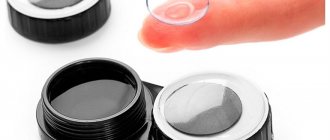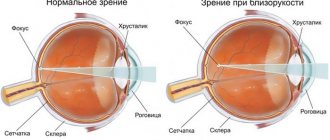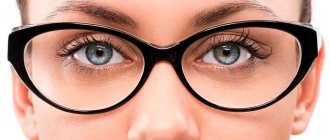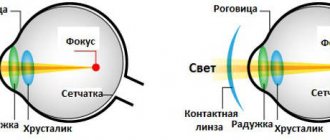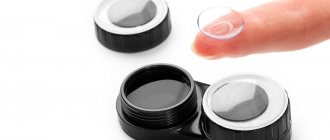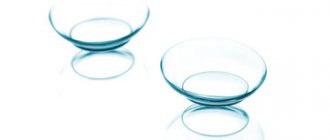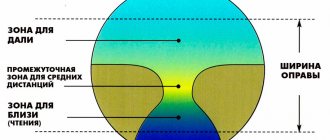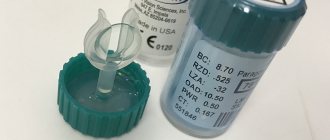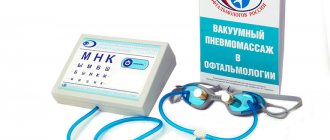Famous lens manufacturers
Modern technologies make it possible to produce glasses of any shape and with purely individual lens properties.
Essilor is an international company that has been producing spectacle lenses for the second century. Over many years of experience, this company has acquired an impeccable reputation and many satisfied clients. It is notable for the fact that it not only produces lenses, but also independently conducts all the research, developing the technological process.
Essilor was the first to market lenses made from polymer materials. The leader in the optical industry has produced renowned lenses coated with Crizal. It protects the surface of the lens from dirt, water, scratches, and glare.
Hoya - these lenses originated from Japan and first appeared in 1941. The company is the progenitor of the technology of applying antireflection coating to glass lenses. It is famous for its strict quality control and wide range of products.
Rodenstock is a company from Germany that has been doing its business since the end of the 19th century. In addition to spectacle lenses and frames, it produces optical equipment. Rodenstock is a symbol of German quality and modern technology.
Carl Zeiss - this company began with a small workshop producing and selling mechanical and optical instruments. Carl Zeiss, the founder of the company, created the first apochromatic lenses.
Choosing which lenses for glasses are best from the companies presented is quite difficult. After all, all famous manufacturers have a rich, more than 100 years of experience and modern technologies in their arsenal. It is these combinations that allow them to remain market leaders for many years.
Rodenstock
The German concern Rodenstock is on the list of undisputed market leaders. The company has more than 140 years of experience in creating optical products. Today, Rodenstock spectacle lenses are high-precision products for solving most visual problems.
The company has innovative equipment in its arsenal, which allows you to create lenses according to individual client parameters. For example, the modern DNEye Scanner allows you to get a virtual “cast” of the eye and complete information about the state of vision – its acuity and the presence of any impairments – in just one and a half minutes.
The information received from DNEye Scanner is processed and transferred to the next stage - the design of individual spectacle lenses. The project is sent to the Rodenstock production facility, where the lenses are manufactured.
Thanks to a fully automated process, a company can use DNEye Scanner
anywhere in the world.
This technology is already available in St. Petersburg: the necessary equipment has been installed in Megaoptika of the “Happy Look” network
. The check takes a minimum of time, and the result is impressive - spectacle lenses created based on individual parameters allow you to use your visual potential at 100%. At the same time, the eyes in such glasses do not get tired, and getting used to the new optics occurs in the shortest possible time.
Rodenstock brand products belong to the premium segment. These are expensive and high-quality lenses that are made from the best materials. The company's product range includes lenses with photochromic properties, mono- and bifocal, progressive, and office lenses. By the way, the German concern was one of the first to produce spectacle lenses with different optical zones, that is, progressive ones.
In addition, Rodenstock offers modern corrective lenses for sports glasses, which allow people with visual impairments to lead a full, active lifestyle.
The company annually develops its own product range and spends a significant amount on searching for new solutions for optics. Thanks to this, Rodenstock has secured its status as an innovator and one of the most technologically advanced manufacturers of spectacle lenses.
Material of manufacture
Most ophthalmologists recommend glass lenses, but this issue should be carefully considered, depending on the type of activity performed while wearing glasses with these lenses.
Currently, there are two options for the material for making spectacle lenses. The first and more traditional of them is inorganic glass. These lenses are called mineral lenses. The substance for making lenses is obtained by melting and cooling glass-forming components.
By varying the chemical composition, you can change the optical characteristics of the material: refraction, density, Abbe number.
Much later, polymer lenses, also called organic lenses, were invented. They are made from synthetic polymer materials with various additives. They are divided into thermosets and thermoplastics.
Glass
Advantages:
- The hardness of the material, due to this factor, glass lenses are highly resistant to scratching the surface.
- Resistance to wear – glass products retain their original appearance longer.
- High heat resistance and light resistance.
- The surface of mineral lenses has better adhesion to various coatings.
For people suffering from a large deviation from unity, mineral lenses remain the only choice. Glass has a higher degree of refraction, so in order to avoid large lens thickness, ophthalmologists advise their patients with a similar problem to give preference to products made from inorganic glass.
Flaws:
- The main disadvantage of glass products has always been their fragility. And if you take into account how close the glasses are to such an important organ as the eyes, then you need to keep in mind that the likelihood of injury is much higher than when using plastic lenses.
- The use of such optical correction devices by children is unacceptable.
Organic lenses are heavy, and with constant use of such glasses, the bridge of the nose becomes tired. Due to their weight, glass lenses are rarely used with rimless or semi-rimless frames.
Plastic
To choose between glasses or contact lenses, consult an ophthalmologist, he will reveal the pros and cons of using both.
For a long time, inorganic glass was the priority material for the manufacture of spectacle lenses. This happened due to many shortcomings in polymer products. But now organic lenses are increasingly crowding out competitors. In recent years, the technology for producing optical products from plastic has advanced greatly and is not much inferior to glass.
Advantages:
- Light weight, which means less strain on the bridge of the nose.
- High impact resistance of the product; if dropped, the polymer lenses will remain intact, and even if they break, it will be into several large pieces of plastic, and not a thousand fragments.
- Good digestibility of dyes used to produce multi-colored lenses.
- Resistance to UVA and UVB ranges of ultraviolet radiation.
The only significant drawback during use of organic lenses was the low resistance to scratches.
To solve this problem, special reinforcing coatings are applied to the surface of plastic lenses, which extend their service life.
Rating of the best eyeglass lens manufacturers for 2021
Bifocal
Let's tell you a little about this type of lenses. Their peculiarity is the presence of 2 sectors. The first (upper) is designed for a person to see well in the distance. It makes the picture clearer. The second (lower) performs the function of clear vision of objects located near a person. Often, this type is used by people who begin to develop farsightedness with age. The problem becomes especially acute when it is impossible to view objects close up.
Synchrony Bifocal CT28 1.5 PhotoFusion HMC+
The product is made in Germany and is made of durable, but at the same time lightweight plastic. Includes dirt-, water-repellent and antistatic functions. This makes it possible to avoid wiping the lenses longer, and if contamination is not avoided, it will be quite easy to remove it.
This option is recommended for people older than 50+. They most often face a situation where it is already problematic to see objects close up.
Synchrony Bifocal CT28 1.5 PhotoFusion HMC+ lenses
Advantages:
- made of high-strength material;
- do not cause discomfort in the eyes.
Flaws:
- high price - from 10 thousand rubles.
OSA-LITE 1.56 ECOLITE BIFOCAL FLATTOP HMC EMI/UV400/HMC Photochromic Bifocal BROWN
This option is more budget-friendly, as it will cost only 1,750 rubles.
There is a multi-coating, which results in high light transmission. In addition, it makes caring for your glasses much easier. Like the previous sample, this one is made of organic plastic.
Your eyes will be reliably protected from ultraviolet radiation. Those who have already become the owners of these lenses rate the quality of this manufacturer highly.
lenses OSA-LITE 1.56 ECOLITE BIFOCAL FLATTOP HMC EMI/UV400/HMC
Advantages:
- high quality sample;
- acceptable price.
Flaws:
- not detected.
WEIYA, Bifocal 1.5
An even cheaper option. There is no longer any coating that would improve quality, but despite this, the lenses perform their main function. Suitable for daily use with careful care.
WEIYA lenses
Advantages:
- availability - only 600 rubles;
- copes with its main function.
Flaws:
- not detected.
Spectacle Lens Top Vision, SP 1.5 Bifocal FT28 HMC
The manufacturer of this model is Germany. Used to correct existing vision problems. It has multi-coating, the advantages of which we discussed above.
Manufacturers make lenses from photochromic polymer in two colors, namely gray and brown.
The price for 1 lens from a pair is on average 1800 rubles.
Top Vision lenses, SP 1.5 Bifocal FT28 HMC
Advantages:
- contributes not only to maintaining the existing level of vision, but also to its correction;
- is in the middle price segment.
Flaws:
- not detected.
Office
This type of lens has absolutely nothing to do with the age of its wearer. They are used by those who spend a lot of time sitting at the computer. In this case, there is a lot of strain on the eyes, as a result of which a person’s vision deteriorates. Let's understand the concept.
Office lenses or glasses are a modern term in the field of medicine, in particular ophthalmology. The use of such glasses guarantees clear vision both near and at a distance. Those. You no longer need to keep several types of glasses on hand to work in comfort.
The structure of such lenses is such that you can both read and examine objects at an average distance.
This type is in demand among specialists because:
- no need to strain your back and neck to make work comfortable;
- there is no strain in the eyes during prolonged use, while making movements from the monitor screen down to the documentation;
- While most other types of lenses require time for the eyes to get used to, this is not required here (they are quite universal for any age).
Nikon 1.5 Soltes Wide
An excellent option for working for a long time, while typing on the computer and working on papers that are on the table.
There is a coating that repels moisture and dirt well. In addition, this model provides increased visual acuity and contrast. With these lenses, your eyes will be reliably protected from radiation that comes from computer screens.
If we compare the material from which the sample is made, it is almost half lighter than glass. Many people recommend using them in rim frames due to the less elasticity of the material.
Nikon 1.5 Soltes Wide lenses
Advantages:
- excellent option for office work;
- high quality model.
Flaws:
- not detected.
Cost – 3450 rubles.
ESSILOR VX Start 080 1.5 Crizal Alize+ UV
A plastic sample manufactured in France. Many describe it as an excellent modern alternative to special reading glasses. Suitable for those who work with objects located close or at a medium distance.
The symmetry design is done to create a wide reading area.
In addition to the preventive function, these lenses correct the minimal degree of visual impairment.
Coverage should be discussed separately. It uses high-tech layers that repel moisture, dust and create an antistatic effect. The surface is also resistant to greasy fingerprints, etc.
In view of all the above functionality, the price tag is set at just over 4,000 rubles.
lenses ESSILOR VX Start 080 1.5 Crizal Alize
Advantages:
- suitable for long-term work;
- have a residual green reflex;
- Wide area for working with papers.
Flaws:
- not detected.
RODENSTOCK, Multigressiv Ergo Room/PC/Book 1.6 – STK Ultrasin
Lenses from this company are an excellent option for those who want to correct their vision, and if problems are associated with different distances, then there is no need to purchase several glasses with different lenses. It can be solved with these lenses from the manufacturer Ergo.
Let us note some features of this sample. For example, when creating it, experts took into account such a parameter as the distance between the pupils, which makes it more comfortable to use. At the same time, everyone can choose the design that is their priority (for different types of distances).
This product is produced in 2 places:
- In Germany.
- In Russia (Ekaterinburg).
The only difference is the price. In the first case it is 13,600, and in the second – 13,000. The amounts are indicated per pair. On the company's website you can find information that these prices are from five years ago, and discounts are now available.
lenses RODENSTOCK, Multigressiv Ergo Room/PC/Book 1.6
Advantages:
- One pair of glasses can correct a problem that can be solved by several pairs;
- if we compare analog products with such characteristics, then this one is the most budget-friendly;
- do not cause discomfort when worn for a long time.
Flaws:
- not detected.
Top Vision, Work Premium 1.67 HMC
We met this manufacturing company a little higher. Now let's look at the office type. A multi-coating is used, which greatly facilitates maintenance and eliminates discomfort during use.
All products are made using a special technology called Free Form. It is equipped with advanced equipment from a German company. What does it give? It provides the opportunity to create exactly the product that fits a person’s individual visual parameters, as well as frames. Industrial painting is used and a special sealing coating is applied. After the sample is completely ready, it undergoes a thorough check on special equipment, where optical power, light transmittance, susceptibility and resistance to ultraviolet radiation, etc. are measured. As a result, we get a high-quality product, perfect for working in the “PC - desktop” mode.
Top Vision lenses, Work Premium 1.67 HMC
Advantages:
- quality product;
- taking into account individual media parameters;
- Availability – 7600 rubles.
Flaws:
- not detected.
Progressive
According to its basic principles, this type of lens is similar to bifocals, but it has a number of features. For example, the type we are considering has a slightly higher price, and it is also visually impossible to detect the dividing strip that delimits zones for long, medium and short distances. When using them, it will take time for your eyes to get used to them. Let us highlight a number of advantages over other types:
- there is no need to buy several pairs of glasses for different activities;
- as mentioned above, there is no separation between zones, while bifocals cannot boast of this;
- create the effect of “natural vision” and visually look like regular glasses.
Many people mistakenly believe that after a short time, feeling discomfort in the eyes, progressive lenses are not suitable for a person. It takes more time for your eyes to get used to it. Let's move on to a review of the best representatives of this species.
Impression FreeSign®3
Perhaps this is the best example of this manufacturer. It differs in a number of parameters. One of them is the fact that it is individual, in other words, capable of adapting to the daily features of the life of its carrier. Those who have tried this product for themselves for a long time note excellent impressions of the quality of vision.
Despite the fact that the progressive type requires long-term adaptation, here this period is significantly reduced. There are no difficulties with perception and vision is completely natural.
The consumer is offered several design options to choose from, based on individual lifestyle and visual needs.
We have already said that the price of such models is an order of magnitude higher than other types. Here it is 55 thousand rubles per couple.
Impression FreeSign®3 lenses
Advantages:
- quick adaptation of the eyes;
- clarity and naturalness of vision;
- high-tech product quality.
Flaws:
- high price.
Essilor X'ion 1.5
In the manufacture of goods, a technology specially patented by this company is used. Due to this, high quality vision is ensured, regardless of the distance used. The available special Crizal UV coating protects the product from radiation and makes it easier to care for.
In addition to comfort, these lenses also provide correction for presbyopia.
Ophthalmologists recommend using the type we are considering with vision from plus 2.00 to minus 3.00.
A pair will cost about 7 thousand rubles.
Essilor X'ion 1.5 lenses
Advantages:
- patented manufacturing technology;
- acceptable price.
Flaws:
- there are restrictions on use.
Shamir Piccolo
This model is designed exclusively for thin frames. Let's look at the parameters. There is a wide area for comfortable reading. You can choose a color when purchasing. Suitable for vision correction. If you order a model via the Internet, you must indicate the recipe, which will become the basis for the manufacture of lenses.
Shamir Piccolo lenses
Advantages:
- comfortable use;
- affordable price, on average - 11 thousand rubles for 2 pieces.
Flaws:
- Only suitable for small frames.
ESSILOR 1.5 ORMA X'ION CRIZAL ALIZE + UV
Quite a budget option, taking into account the fact that glasses with these lenses can not only comfortably lead everyday life or work, but also correct a mild degree of ametropia. Like other representatives of this company, this sample has a multi-coating and a special manufacturing technology.
Speaking of limitations, it is not recommended to use these lenses in frames that do not have a rim.
lenses ESSILOR 1.5 ORMA X'ION CRIZAL ALIZE
Advantages:
- affordable price - about 10 thousand rubles;
- Excellent value for money and quality.
Flaws:
- not detected.
Selection of refractive index
Refraction is an important property that determines the thickness and volume of the lens, and the percentage of reflection from its surface. Choosing the right coefficient affects the comfort of use and the attractive appearance of the glasses.
A higher refractive index means better optical properties: the lens is thinner, lighter, stronger and more expensive.
To select glasses with the required refractive index in an optics salon, you need to pay attention to the prescription written by an ophthalmologist. If a person has a greater degree of visual impairment, then he is advised to use lenses with a high refractive index.
The higher the refractive index of the material, the thinner and flatter the finished spectacle lens will be, which means the glasses will be more comfortable for the user and aesthetically pleasing in appearance.
The coefficient may also change depending on the choice of frame. Using a plastic frame, you can choose a lower refractive index, since in this case a thick lens will be less noticeable.
Lens coating options
Often, several layers of coatings are applied to glasses lenses.
To improve the properties and extend the service life of plastic lenses, special coatings are applied to their surface:
- Strengthening – protects the surface from scratches.
- Water- and dirt-repellent – increases resistance to dirt formation and makes lenses easier to clean.
- Antistatic – prevents the accumulation of dust and the accumulation of static electricity.
- A coating that protects against blue-violet light emitted by electronic device screens.
- Chromatic – protects the visual organ from excessive bright light.
- Anti-reflective – improves lens clarity, reduces glare and thus reduces visual strain.
Many manufacturers now offer their consumers the use of glasses with multifunctional coatings that solve several problems at once. They usually use hardening, water-repellent and antireflective coatings.
What types of glasses lenses are made in Germany?
All lenses are divided into two types, depending on the material:
polymer, that is, created from plastic, which in turn have several varieties. They differ in the quantity and quality of base coatings - anti-reflective, strengthening, antistatic;- mineral, made from glass. Less popular with consumers because they are heavier than plastic and are not suitable for every frame. For example, in thin metal or screws, their weight may cause deformation of the mounting screws.
The terms of use of lenses depend on the quality and class of coating . A large volume of optical products from German manufacturers is occupied by world leaders such as Rodenstock, Rupp und Hubrach and Zeiss, which are guarantors of unsurpassed quality. Let's talk about each of them separately, as they all deserve attention.
Rodenstock
The company was founded in 1877, and began producing spectacle lenses in 1878. Over the 140 years of its existence, it has gained extensive experience and an excellent reputation, using unique, cutting-edge technologies. Modern coatings are regularly developed to improve wearing comfort.
The mineral optics have a double-sided Multisin coating with residual reflex and a super-effective Supersin coating with dirt- and water-repellent properties.
Polymer lenses have a wider range of coatings:
- Duralux – hard varnish reliably protects the lens from mechanical damage in the form of scratches, but there is no anti-reflex layer;
- NS Supersin - a multilayer solid anti-reflex and hydrophobic coating protects against water, dirt and fogging during temperature changes;
- Supersin – does not have the properties of the previous one, but has super-anti-reflex properties;
- Ultrasin – applied on both sides, combined, increases the contrast of vision;
- TopCoat - includes all the latest technologies from the company. High scratch resistance, grease-moisture resistance, excellent light transmittance, eye-relaxing effect. Anti-reflex technique creates the feeling of the absence of lenses, which do not require frequent cleaning and have a long service life.
- Solitaire Protect Plus - in addition to the parameters described above, it is characterized by antistatic properties that repel microscopic dust particles.
Rupp und Hubrach
The manufacturer of premium optics began its activities in 1922. A wide range consists of polymer and polycarbonate raw materials:
YSIS is a group of monofocal personal optics. Takes into account the anatomical individuality of the face and visual stereotypes;- SPORTS – the basic wide curvature is designed specifically for sports and sun protection, improves panoramic visibility and adequate distance assessment . Thus increasing human safety during sports activities;
- Joker - contain a refractive index in the range from 1.5 to 1.67 and are affordable;
- Express - equipped with a multifunctional coating on both surfaces to improve consumer properties using nanotechnology.
Zeiss
160-year history in the production of optics of various directions. Revolutionary technologies with a refraction range from +20 diopters to -30. The design of some lenses takes into account a person's visual characteristics and facial anatomy . Variability makes it possible to individually select coatings - water-repellent, abrasion-resistant, protective against UV rays, and relieving visual fatigue.
Lenses for working at a computer
The harm of a computer to a person’s visual organ is the constant tension of the eye muscles, screen glare and incorrect posture when the screen is at an unsafe distance.
The result of frequent work at the monitor is: dryness, burning sensation, sand, foreign body, redness of the eyes, fear of bright light, watery eyes.
For those who work at a computer all day, ophthalmologists recommend using special glasses. They can be purchased by both a person in need of correction and a person with normal vision. A special coating is applied to the surface of such lenses, which reduces the brightness of the image while increasing its clarity. Therefore, the eyes are less strained and, accordingly, less tired.
Lens shape
Modern production technologies make it possible to develop lenses not only with a high refractive index and different optical zones, but also of various geometric shapes. The shape affects the thickness, lightness of the frame, the aesthetic appearance of a person, and the brightness of peripheral vision. Based on their shape, lenses are divided into:
- stigmatic or spherical;
- astigmatic or aspherical;
- bifocal or biaspherical;
- progressive or trifocal.
Stigmatic form
This is one of the most popular designs - convex. The spherical shape is inexpensive and suitable for almost any occasion. The surface of such glasses is marked point by point with identical diopters and has an equal radius of curvature. The spherical elements provide high-quality vision only in the central part, the curved side gives a distorted view to the sides. There are two types of stigmatic form:
- biconvex – for correction of farsightedness;
- biconcave – to correct myopia.
Astigmatic
These are lenses in which one or two surfaces are non-spherical. Thanks to this geometric feature, they have minimal optical distortion of objects. When wearing aspherically shaped accessories, a distortion in the size of the eyes may occur. Disadvantages include multiple reflections that appear on the surface of the glass, which is why they are often produced with a special anti-reflective coating. Astigmatic type is prescribed to people with a high degree of myopia or farsightedness.
Bifocal lenses
They have two spherical surfaces on the inside and on the outside. The specific construction provides the widest possible overview and clarity of the image of objects. In addition, the bifocal shape is thinner compared to other types. Ophthalmologists recommend wearing it with high diopters or astigmatism, when the patient needs the lightest possible design.
Progressive
If earlier people bought several types of glasses at once (some for vision, others for watching TV or reading), today scientists suggest using progressive lenses. At the top there is an area for distance vision, and at the bottom for viewing nearby objects. They do not blur the contours of objects when moving from one type of vision to another. The only disadvantage is that it takes a long time to get used to. They are not recommended for patients who have cataracts, strabismus, or a large difference in diopters between the right and left eyes.

